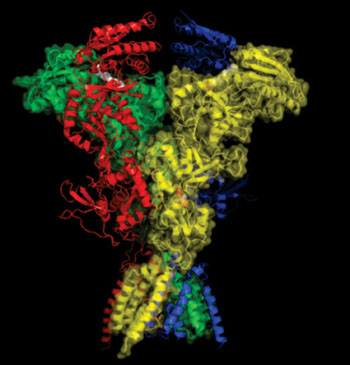X-Ray Crystallography Offers First-Time 3D View of Vital Brain Receptor
By LabMedica International staff writers
Posted on 07 Jul 2014
Researchers have produced a new and extraordinary three-dimensional (3D) view of one of the most important receptors in the brain—a receptor that allows humans to learn and remember, and whose malfunctioning is involved in a wide variety of neurologic disorders, including Alzheimer’s, Parkinson’s, depression, and schizophrenia.Posted on 07 Jul 2014
The never-before-seen view provided was published online June 22, 2104, in the journal Nature, and offers new clues into how the receptor, called the N-methyl-D-aspartate (NMDA) receptor, is structured. Moreover, the new detailed view offers vital clues to developing drugs to fight the neurologic diseases and conditions. “This is the most exciting moment of my career,” said Dr. Eric Gouaux, a senior scientist at the Oregon Health & Science University’s Vollum Institute (OHSU; Portland, USA). “The NMDA receptor is one of the most essential, and still sometimes mysterious, receptors in our brain. Now, with this work, we can see it in fascinating detail.”

Image: X-ray crystal structure of the NMDA receptor showing its mushroom-like shape, with receptor subunits in different colors (Photo courtesy of Oregon Health & Science University).
The NMDA receptor is one of the most significant brain receptors because it helps in neuron communication that is the basis of memory, learning, and thought. Dysfunction of the NMDA receptor occurs when it is more or less active and is tied to a wide range of neurologic disorders and diseases.
Scientists worldwide study the NMDA receptor; some of the most notable discoveries about the receptor during the past 30 years have been made by OHSU Vollum scientists.
The NMDA receptor structure includes receptor subunits, all of which have distinctive characteristics and act in distinct ways in the brain, sometimes causing neurologic difficulties. Before this research, scientists had only an inadequate view of how those subtypes were arranged in the NMDA receptor complex and how they interacted to carry out specific functions within the brain and central nervous system.
The team of scientists created a 3D model of the NMDA receptor through a process called X-ray crystallography. This process throws X-ray beams at crystals of the receptor; a computer calibrates the composition of the structure based on how those X-ray beams spring off the crystals. The resulting 3D model of the receptor, which looks similar to an arrangement of flowers, reveals where the receptor subunits are positioned, and offers unprecedented insights into their actions. “This new detailed view will be invaluable as we try to develop drugs that might work on specific subunits and therefore help fight or cure some of these neurological diseases and conditions,” Dr. Gouaux said. “Seeing the structure in more detail can unlock some of its secrets—and may help a lot of people.”
Related Links:
Oregon Health & Science University’s Vollum Institute








 (3) (1).png)




